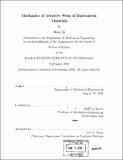Mechanics of abrasive wear of elastomeric materials
Author(s)
Qi, Hang, 1971-
DownloadFull printable version (37.97Mb)
Other Contributors
Massachusetts Institute of Technology. Dept. of Mechanical Engineering.
Advisor
Mary C. Boyce.
Terms of use
Metadata
Show full item recordAbstract
Elastomeric materials are widely used as tire and sealing materials due to their ability to undergo large deformations and conform to the mating surface. However, their applications often result in repeated contact with abrasive particles, which act to abrasively wear the elastomers. Elastomeric materials are observed to exhibit a characteristic form of abrasive pattern on the surface after cyclic scratching. The dimension of this pattern is closely related to the wear rate, whereas the formation of this pattern is controlled by abrasive particle sizes, material mechanical properties, loading conditions, thermal conditions, and chemical degradation of materials. Much research has been conducted in the past. However, direct observations of the wear process are rare. The mechanics underlying the abrasive wear of elastomeric materials is unclear. In order to provide fundamental understanding of the abrasive wear of elastomeric materials due to abrasive particle indentation and scratching, this research studied the wear of elastomeric materials subjected to scratching by knife geometries that simulate abrasive particles and contact conditions. Efforts were focused on establishing direct observations and analysis of the deformation mechanics. An in situ micro scratching test capability operating within a scanning electron microscope (SEM) was developed and used together with image processing to reveal the local deformation fields. Surface profile analyses using both SEM and ZYGO (a non-contact interferometer) were also conducted to observe the surface change during cyclic scratching. The large strain nonlinear stress-strain behavior of thermoplastic polyurethanes (TPUs) exhibits strong hysteresis, rate dependence and cyclic softening. (cont.) In this work, a constitutive model capturing the major features of the stress-strain behavior of TPUs was developed. The model decomposed material behavior into an equilibrium component and a rate dependent deviation from equilibrium. The cyclic softening behavior was attributed to be due to the softening of the equilibrium path as a result of the evolution of the effective volume fraction of the soft domain during deformation, upon which the occluded soft material was released to carry load due to the relative motions among hard domains. Extensive finite element (FE) based simulations of indentation and scratching tests using the proposed constitutive model were conducted. The FE model was verified by comparing the variation of normal and tangential forces and the distributions of displacement and strain fields with those experimentally obtained. The FE simulations revealed that the transition from the stick phase to the slip phase during scratching was accompanied by a large increase in molecular stretch and maximum principal stress (tensile stress), thus creating conditions for damage initiation. The FE model was then used to investigate the effects of contact conditions, cyclic scratching, friction, scratching speed, and material properties on the variation of molecular stretch and maximum principal stress. The effects of fiber fillers were also investigated by considering three representative fiber orientations: Horizontal, vertical, and lateral orientations. It was found that, for the fiber geometries and abrasive particle geometries studied, fibers do not enhance material wear resistance.
Description
Thesis (Sc. D.)--Massachusetts Institute of Technology, Dept. of Mechanical Engineering, 2003. Includes bibliographical references.
Date issued
2003Department
Massachusetts Institute of Technology. Department of Mechanical EngineeringPublisher
Massachusetts Institute of Technology
Keywords
Mechanical Engineering.